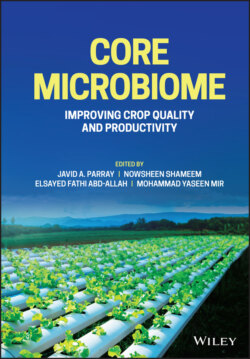Читать книгу Core Microbiome - Группа авторов - Страница 43
3.1 Introduction
ОглавлениеMedicinal plants are a major group of crops that are considered very valuable due to their role in helping people maintain good health. These medicinal plants are traditionally used as herbal formulations for the prevention and treatment of diseases (Williamson 2003). About 80% of the world’s population depends on medicinal herbs directly or indirectly as reported by the World Health Organization (Kasilo and Trapsida 2010). These medicinal plants are associated with many beneficial bacteria. The microbes have a positive and antagonistic effect with other microbes in the soil. Moreover, the rhizosphere biome helps plants grow as well as manage pathogenic microorganisms residing in the rhizosphere ruthlessly to break the protective shield and overwhelm the innate plant defense mechanism (Hashem et al. 2017; Dubey et al. 2019.
Bioactive phytochemicals were the focus of previous medicinal plant research, however, because to the realization that a considerable number of phyto-therapeutic chemicals are really created by related microorganisms or through contact with their host, the focus is currently moving. The host rhizosphere, a narrow zone of the soil contains more than 30,000 prokaryotic species and a large number of microbial cells in a one-gram root (Berendsen 2012). These are attracted by rhizosphere plant root secretion and deposits into the soil. Among all microbes, Bacillus and Pseudomonas are well-known genera that are used to produce organic biofertilizers and improve soil fertility and biogeochemical cycles for better growth of the entire plant (Freitas et al. 2004). The tolerance and secondary metabolites mechanism for commercial medicinal plants has not been investigated. So, there is a need to determine the response of medicinal plants under stress conditions, as salt stress reduced the quality of essential oils and secondary metabolites in medicinal plants. Both biotic and abiotic stresses are significant constraints in agriculture production, which is affected by several factors such as hormonal and nutritional imbalance, ion toxicity, physiological disorders, and susceptibility to disease (Dubey et al. 2018; Malla et al. 2018).
In this study, we discuss plants and microbes and their interaction with the microbiomes and implications of abiotic stresses toward medicinal plant response; physiological, biological, and molecular mechanisms; and microbe-mediated stress-alleviation processes. Less information is available for the molecular mechanism of metabolites in medicinal plants. Modern omics approaches, i.e. quantitative trait loci, functional genomics techniques, proteomics, and mass spectrometry, are used to understand plant–microbe interactions to optimize under abiotic stresses (Kumar and Dubey 2020).
